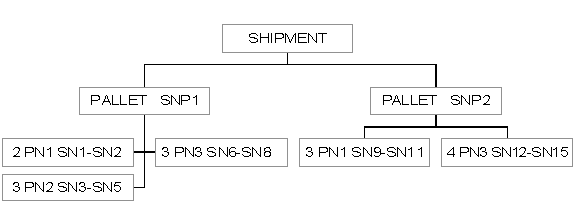|
 |
| 1. Introduction |
Status
| MESSAGE TYPE |
: DESADV |
| REFERENCE DIRECTORY | : D.01B |
| EANCOM® SUBSET VERSION | : 007 |
Definition
A message specifying details for goods despatched or ready for despatch under agreed conditions.
Principles
The message may be used either to indicate the despatch of goods being delivered, or to indicate the despatch of goods being returned.
The message intent is to advise of the detailed contents of a consignment.
The message relates to one seller and one buyer or their respective agent.
The message relates to a single despatch point and single or multiple destination points. It may cover a number of different items and packages.
It allows the recipient to:
- know when the material has been despatched or will be ready for despatch.
- have the precise details of the consignment.
- take initial steps towards customs clearance in case of international consignments.
- enable the control between despatched goods with the following invoice.
The Despatch Advice message should always be sent before goods are physically delivered or returned. This makes it possible for the receiving party to use the data to prepare efficiently for the reception of the goods.
Each unit delivered (pallet, carton, ...) should be uniquely identified. In the Despatch Advice message, the products contained in each uniquely identified unit are described. When the goods are received, the physical shipment and the electronic message can be cross-checked. Discrepancies are immediately identified. It is recommended to use the standard GS1 Serial Shipping Container Code structure to identify the units (see Part I, section 4.2).
Structure of the Despatch Advice
message
The message enables a hierarchical description of the shipment, starting with the highest level (shipment) and ending with the lowest level (items). One can for example describe a container comprising 5 pallets, a pallet being composed of several large despatch units which themselves contain smaller despatch units. The traded units (any level of packaging agreed by the trading partners) are then specified.
It is however not mandatory to describe the hierarchical structure of the shipment. A simple and probably most frequent use of the message consists in specifying the items to be despatched and the relevant information per item (quantity, additional identification ...).
Example
The following example is used to illustrate the different descriptive options of the Despatch Advice message. Options 1 through 4 are presented in an ascending order of complexity or completeness.
A shipment consists of 2 pallets. The first pallet, identified by the serial number SNP1, contains 8 cartons. 2 cartons of product number PN1, 3 cartons of PN2 and 3 cartons of PN3. The cartons are individually identified by serial numbers ranging from SN1 through SN8.
The second pallet identified by the serial number SNP2, contains 3 cartons of product number PN1 and 4 cartons of product number PN3. The cartons are individually identified by serial numbers ranging from SN9 through SN15.
The shipment can be represented like this:

Please note that for easy reading, the product numbers (PN's) and the serial numbers (SNP's, SN's) have been shortened. In real transactions, standard GTINs and the Serial Shipping Container Code should be used. The message structure has been simplified with only the functional segments of the detail section presented.
Option
1:
Only product numbers and total shipment quantities are provided, no carton specific serial numbers are provided and no description of the shipment structure is given.
This option allows for the description of the shipment composition only in terms of products and total quantities per product. In this case the shipment is described as being composed of 5 units of PN1, 3 units of PN2 and 7 units of PN3. Using this option, the message will provide no information regarding individual despatch carton serial numbers or the way they are organised hierarchically in the shipment, i.e. the shipment consists of two pallets, the first containing..., the second pallet containing...,.
Option 1 Detail Section of the
Despatch Advice Message:
| CPS+1' | "Dummy" CPS segment |
| LIN+1++PN1:SRV' | First line item; PN1 |
| QTY+12:5' | Quantity Despatched 5 |
| LIN+2++PN2:SRV' | Second line item; PN2 |
| QTY+12:3' | Quantity Despatched 3 |
| LIN+3++PN3:SRV' | Third line item; PN3 |
| QTY+12:7' | Quantity Despatched 7 |
Option
2:
Product numbers and total quantities of the shipment are provided. Additionally, each carton is uniquely identified by a serial number. No description of the structure of the shipment is given.
This option allows for the description of the shipment composition but ignores any hierarchical structure of the shipment. In this case the shipment is described as being composed of 5 units of PN1, 3 units of PN2 and 7 units of PN3. Additionally, each carton is uniquely identified by a serial number so as to distinguish cartons with the same product number, so that for example cartons PN1 will be identified with the serial numbers SN1, SN2, SN9, SN10 and SN11. This option does not provide information on how the groups of cartons are organised in the shipment, (i.e. in terms of pallets).
Option 2 Detail Section of the
Despatch Advice Message:
| CPS+1' | "Dummy" CPS segment |
| LIN+1++PN1:SRV' | First line item; PN1 |
| QTY+12:5' | Quantity Despatched 5 |
| PCI+33E' | Marked packaging with SSCC |
| GIN+BJ+SN1:SN2+SN9:SN11' | Serial numbers of 5 cartons PN1 |
| LIN+2++PN2:SRV' | Second line item; PN2 |
| QTY+12:3' | Quantity Despatched 3 |
| PCI+33E' | Marked packaging with SSCC |
| GIN+BJ+SN3:SN5' | Serial numbers of 3 cartons PN2 |
| LIN+3++PN3:SRV' |
Third line item; PN3 |
| QTY+12:7' | Quantity Despatched 7 |
| PCI+33E' | Marked packaging with SSCC |
| GIN+BJ+SN6:SN8+SN12:SN15' | Serial numbers of 7 cartons PN3 |
Option
3:
Description of the shipment hierarchical structure in terms of pallet content, with pallets uniquely identified.
This option allows to describe the composition of the shipment in terms of the pallets it contains, each pallet uniquely identified by a serial shipping container code (SNP1 and SNP2). The message describes the composition of each pallet in terms of the cartons contained and in what quantity, per pallet.
Option 3 Detail Section of the
Despatch Advice Message:
| CPS+1' | 1st CPS; no parent |
| PAC+2++201' | Number of packages = 2 pallets type ISO 1 |
| CPS+2+1' | 2nd CPS; first pallet; parent = shipment |
| PAC+1++201' | Outer packaging level, pallet type ISO 1 |
| PCI+33E' | Marked packaging with SSCC |
| GIN+BJ+SNP1' | Serial number of 1st pallet |
| CPS+3+2' |
3rd CPS; 8 cartons; parent = pallet SNP1 |
| PAC+8++CT' |
Pallet contains 8 cartons |
| LIN+1++PN1:SRV' | First line item; PN1 |
| QTY+12:2' | Quantity Despatched 2 |
| LIN+2++PN2:SRV' | Second line item; PN2 |
| QTY+12:3' | Quantity Despatched 3 |
| LIN+3++PN3:SRV' | Third line item; PN3 |
| QTY+12:3' | Quantity Despatched 3 |
| CPS+4+1' | 4th CPS; second pallet; parent = shipment |
| PAC+1++201' | Outer packaging level, pallet type ISO 1 |
| PCI+33E' | Marked packaging with SSCC |
| GIN+BJ+SNP2' | Serial number of 2nd pallet |
| CPS+5+4' |
5th CPS; 7 cartons; parent = pallet SNP2 |
| PAC+7++CT' |
Pallet contains 7 cartons |
| LIN+4++PN1:SRV' | Fourth line item; PN1 |
| QTY+12:3' | Quantity Despatched 3 |
| LIN+5++PN3:SRV' | Fifth line item; PN3 |
| QTY+12:4' | Quantity Despatched 4 |
Option
4:
Description of the shipment hierarchical structure in terms of the pallets and their content. Both pallets and cartons contained are uniquely identified by serial numbers.
This option allows to describe the composition of the shipment in a hierarchical nature. The shipment is identified as being composed of two pallets each identified by a serial shipping container code (SNP1 and SNP2). The message describes the composition of each pallet in terms of the units contained and their serial shipping container codes. Following the same hierarchical logic the message could go on to describe the composition of each carton in terms of its traded or consumer units.
Option 4 Detail Section of the
Despatch Advice Message:
| CPS+1' | 1st CPS; no parent |
| PAC+2++201' | Number of packages = 2 pallets type ISO 1 |
| CPS+2+1' | 2nd CPS; first pallet; parent = shipment |
| PAC+1++201' | Outer packaging level, pallet type ISO 1 |
| PCI+33E' | Marked packaging with SSCC |
| GIN+BJ+SNP1' | Serial number of 1st pallet |
| CPS+3+2' |
3rd CPS; 8 cartons; parent = pallet SNP1 |
| PAC+8++CT' |
Pallet contains 8 cartons |
| LIN+1++PN1:SRV' | First line item; PN1 |
| QTY+12:2' | Quantity Despatched 2 |
| PCI+33E' | Marked packaging with SSCC |
| GIN+BJ+SN1:SN2' | Serial numbers of 2 cartons PN1 |
| LIN+2++PN2:SRV' |
Second line item; PN2 |
| QTY+12:3' | Quantity Despatched 3 |
| PCI+33E' | Marked packaging with SSCC |
| GIN+BJ+SN3:SN5' | Serial numbers of 3 cartons PN2 |
| LIN+3++PN3:SRV' | Third line item; PN3 |
| QTY+12:3' | Quantity Despatched 3 |
| PCI+33E' | Marked packaging with SSCC |
| GIN+BJ+SN6:SN8' | Serial numbers of 3 cartons PN3 |
| CPS+4+1' | 4th CPS; second pallet; parent = shipment |
| PAC+1++201' | Outer packaging level, pallet type ISO 1 |
| PCI+33E' | Marked packaging with SSCC |
| GIN+BJ+SNP2' | Serial number of 2nd pallet |
| CPS+5+4' |
5th CPS; 7 cartons; parent = pallet SNP2 |
| PAC+7++CT' |
Pallet contains 7 cartons |
| LIN+4++PN1:SRV' |
4th line item; PN1 |
| QTY+12:3' | Quantity Despatched 3 |
| PCI+33E' | Marked packaging with SSCC |
| GIN+BJ+SN9:SN11' | Serial numbers of 3 cartons PN1 |
| LIN+5++PN3:SRV' | 5th line item; PN3 |
| QTY+12:4' | Quantity Despatched 3 |
| PCI+33E' | Marked packaging with SSCC |
| GIN+BJ+SN12:SN15' | Serial numbers of 4 cartons PN3 |
|